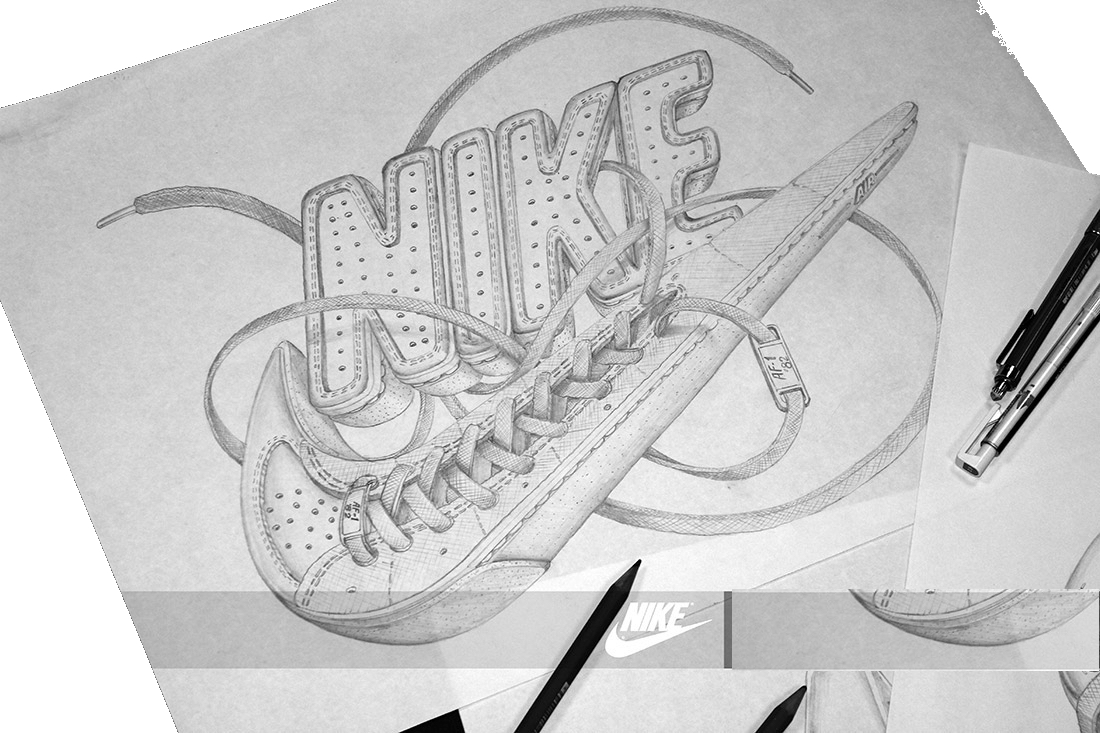Nike is expected to report earnings on Thursday, December 21st after the market closes. Shares of the company are up 23% year-to-date and 12% over the last month so I've decided to update my cash flow analysis prior to earnings to get a sense if the stock has more upside or downside going forward.
Discounted Cash Flow Analysis Overview
This article details how to construct an unlevered discounted cash flow (DCF) analysis for Nike, Inc. (NYSE: NKE) by using finbox.io’s five-year valuation model. Note that unlevered free cash flow refers to the cash a business generates before paying any providers of capital such as debt and equity holders.
The basic philosophy behind a DCF analysis is that the intrinsic value of a company is equal to the future cash flows of that company, discounted back to present value. The general formula is provided below. The intrinsic value is considered the actual value or “true value” of an asset based on an individual’s underlying expectations and assumptions.

Cash flows into the firm in the form of revenue as the company sells its products and services, and cash flows out as it pays its cash operating expenses such as salaries or taxes (taxes are part of the definition for cash operating expenses for purposes of defining free cash flow, even though taxes aren’t generally considered a part of operating income). With the leftover cash, the firm will make short-term net investments in working capital (an example would be inventory and receivables) and longer-term investments in property, plant and equipment. The cash that remains is available to pay out to the firm’s investors: bondholders and common shareholders.
I will take you through my own expectations for Nike as well as explain how I arrived at certain assumptions. The full analysis was completed on Tuesday, December 12. An updated analysis using real-time data can be viewed in your web browser at finbox.io's Nike DCF analysis page. The steps involved in the valuation are:
1. Forecast Free Cash Flows
- Create a revenue forecast
- Forecast EBITDA profit margin
- Forecast depreciation & amortization expenses
- Select a pro-forma tax rate
- Plan/estimate capital expenditures
- Forecast net working capital investment
- Calculate free cash flow
2. Select a discount rate
3. Estimate a terminal value
4. Calculate the equity value
Step 1: Forecast Free Cash Flows
The key assumptions that have the greatest impact on cash flow projections are typically related to growth, profit margin and investments in the business. The analysis starts at the top of the income statement by creating a forecast for revenue and then works its way down to net operating profit after tax (NOPAT), as shown below.
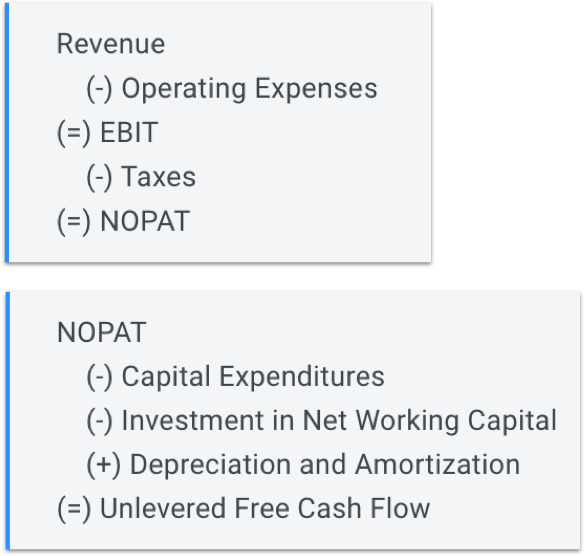
From NOPAT, deduct cash outflows like capital expenditures and investments in net working capital and add back non-cash expenses from the income statement such as depreciation and amortization to calculate the unlevered free cash flow forecast (shown above).
Capital expenditures or fixed capital investment does not appear on the income statement, but it does represent cash leaving the firm, which is why it is subtracted from NOPAT to reach free cash flow. Capital expenditures used in the DCF model represent a net amount, meaning the figure is calculated by subtracting proceeds from sales of long-term assets from capital expenditures. It is the change in capital expenditures that matters for this model.
Working capital is often used as a measure of a company’s efficiency and short-term financial health. It is generally calculated as current assets minus current liabilities.
Working capital investment, or net working capital, in the DCF model is equal to the change in working capital, excluding cash, cash equivalents, notes payable, and the current portion of long-term debt. It’s important to note that one would add the change in working capital to NOPAT if there was reduction in working capital over the period. It would be added back because it represents a cash inflow. This concept is confusing to many. An increase in working capital implies that more cash is invested in working capital and thus reduces cash flow. Firms with significant working capital requirements will find that their working capital grows as they do, and this working capital growth will reduce their cash flows. It is more common to see a cash outflow for the change in net working capital.
Non-cash charges are added back to NOPAT to arrive at free cash flow because they represent accounting losses required to be reported on the income statement but they didn’t actually result in an outflow of cash. The most significant recurring non-cash charges are typically depreciation and amortization. But other non-cash charges or expenses that are typically non-recurring in nature could include:
- Amortization of intangibles,
- Goodwill impairment,
- Asset write-down,
- Provisions for restructuring charges and other non-cash losses (these expected losses should reduce future free cash flow accordingly in the model’s estimates),
- Income from restructuring charge reversals and other non-cash gains,
- Amortization of a bond discount (add back to net income to calculate free cash flow),
- Accretion of a bond premium (subtract from net income to calculate free cash flow),
- Deferred taxes (if you expect that deferred taxes will continue to increase in the future),
- Acquisition expenses representing the costs involved in acquiring a business or a customer (can be cash or non-cash expenses), and
- Litigation expenses relating to legal matters such as settlements and patents.
Finbox.io’s valuation models retroactively adjust historical financials to exclude these non-recurring items. We exclude these items to gain a better sense of how the company has performed in its normal course of business and since they are typically non-recurring charges, their exclusion helps provide a “cleaner” picture for comparing historical performance to projected performance.
Create A Revenue Forecast
When available, the finbox.io’s pre-built models use analyst forecasts as the starting assumptions. To forecast revenue, analysts gather data about the company, its customers and the state of the industry. I typically review the analysts’ forecast and modify the growth rates based on historical performance, news and other insights gathered from competitors. Note that if a company only has a small number of analysts giving projections, the consensus forecast tends to not be as reliable as companies that have several analysts’ estimates. Another check for reliability is to analyze the range of estimates. If the range is really wide, it may be less accurate.
Analysts covering the stock often compare the company to a peer group that includes Under Armour (NYSE: UA), Skechers (NYSE: SKX), Foot Locker (NYSE: FL) and adidas AG (OTC: ADDYY).
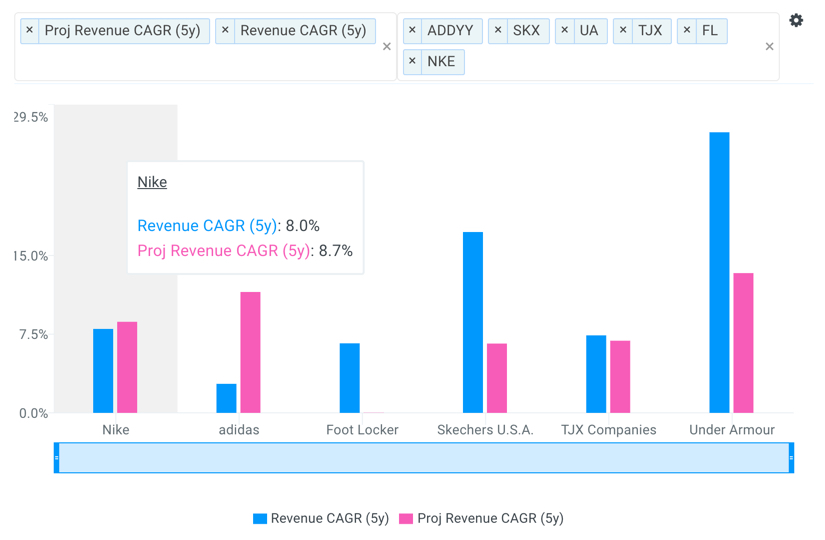
Nike's 5-year revenue CAGR of 8.0% is above selected comparable public companies FL (6.7%) and ADDYY (2.8%) but below UA (26.8%) and SKX (17.3%). Going forward, the company's projected 5-year revenue CAGR of 8.7% is above SKX (6.6%) and FL (0.1%) but below UA (13.4%) and ADDYY (11.6%). Overall, right in the middle of the pack.
As highlighted below, Nike,'s revenue growth has ranged from -0.8% to 16.0% over the last seven fiscal years.
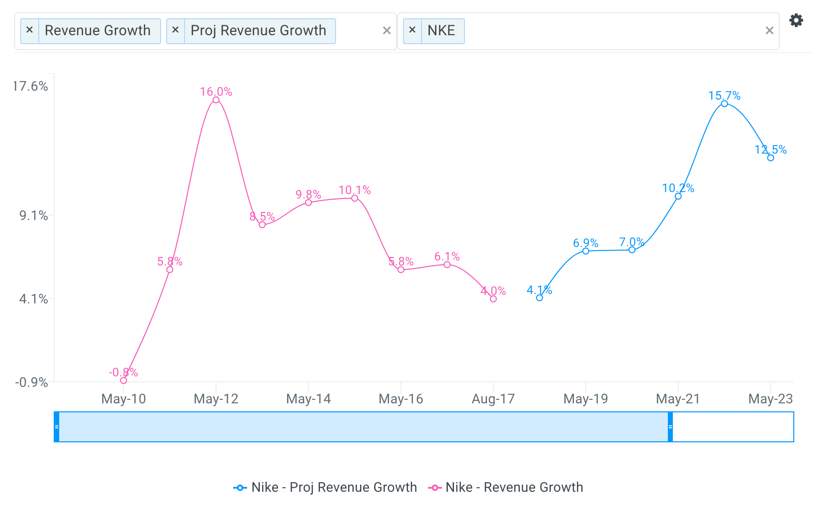
Going forward, analysts forecast that Nike's total revenue will reach $52,180 million by fiscal year 2022 representing a five-year CAGR of 8.7%.
In my model, I conservatively adjusted the growth figures in the final two years so that revenue growth equals 5% in fiscal year 2022. I brought down Wall Street’s rosy outlook starting in 2021 because (a) it seems unreasonable based on Nike’s recent growth trends over the last five years and (b) there are reports that the company’s market share is declining in face of increasing competition.
Reading through investor presentations, earnings announcements and other SEC filings helped me get comfortable with my revenue forecast, which is shown below.

Forecast Nike's EBITDA Profit Margin
The next step is to forecast the company’s earnings before interest, taxes, depreciation and amortization (EBITDA). Note that EBITDA is a commonly used metric in valuation models because it provides a cleaner picture of overall profitability, especially when benchmarking against comparable companies. This is because it ignores non-operating costs that can be affected by certain items such as a company’s financing decisions or political jurisdictions. For more detail, see Nike's EBITDA definition.
EBITDA margin is calculated by dividing EBITDA by revenue. The higher the EBITDA margin, the smaller the firm’s operating expenses are in relation to its revenue, which may ultimately lead to higher profit. Lower operating expenses for a given level of revenue can be a sign of internal economies of scale.
The charts below compare Nike's EBITDA margin to the same peer group.
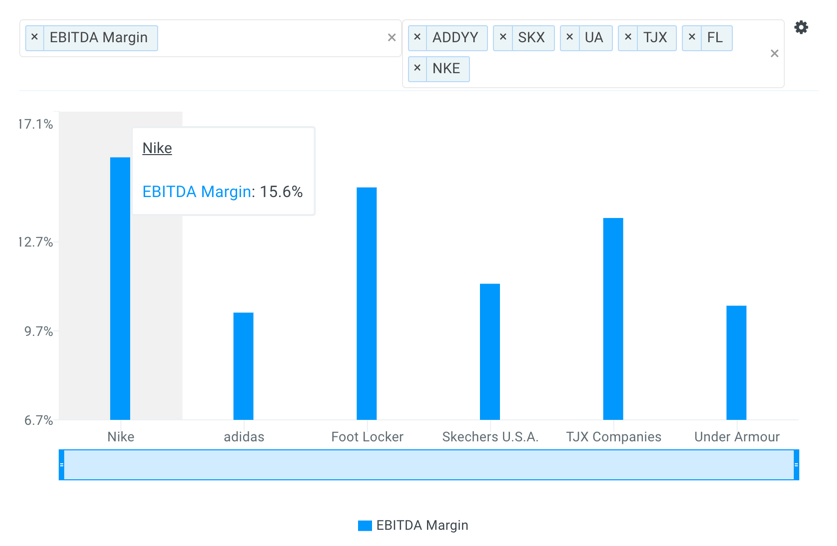
Nike easily boasts the highest EBITDA margins relative to its peers, which currently stands at 15.6%.
The retailer's EBITDA margin has ranged from 15.1% to 16.0% over the last five fiscal years. Wall Street analysts are forecasting that Nike's EBITDA margin will reach 16.9% by fiscal year 2022, representing a reasonable increase of 1.4% from its current EBITDA margin.
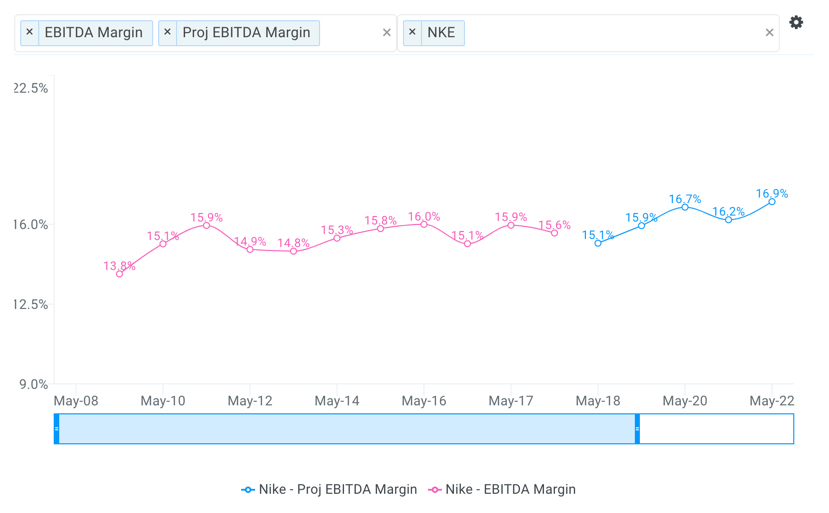
I kept Wall Street's forecast for my EBITDA margin selection below.

Forecast Depreciation & Amortization Expenses
Depreciation and amortization (D&A) are usually embedded in cost of goods sold (COGS) or selling general and administrative expenses (SG&A) on the income statement. The model subtracts D&A to estimate NOPAT but eventually adds it back in the build-up to free cash flow because it’s a non-cash expense. Including it as an expense in the calculation of NOPAT allows the model to capture the tax benefits associated with D&A. While depreciation is a non-cash expense, the firm reduces its tax bill by expensing it, so the free cash flow available is increased by the tax savings.
Nike's historical and forecasted D&A is shown in the charts below.
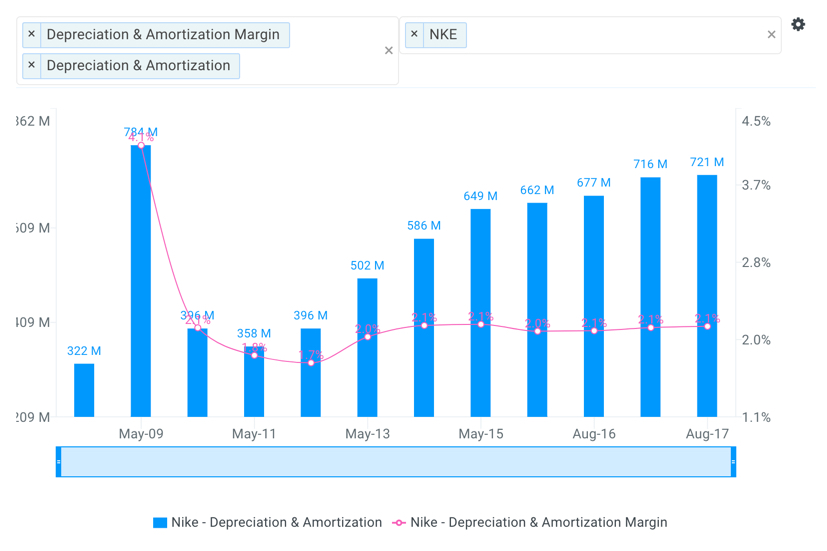
I’ve kept D&A at 2.1% of revenues throughout the projection period, which is in line with its past performance.

Select a Pro Forma Tax Rate
Companies are required to pay a portion of their profits to the governments in the countries in which they operate. A firm’s effective tax rate is calculated from the reported income statement by dividing taxes by operating income before taxes. The marginal tax rate is the rate owed on the company’s last dollar of taxable income. A company’s effective and marginal tax rate is not always the same due to accounting standards related to tax credits, tax deferrals and net operating losses (NOLs) carried forward. However, historical effective tax rates are useful for estimating a company’s marginal tax rate, which is what I use in the model.
Note that investors will want to keep an eye on whether the Trump administration lowers the United States’ marginal corporate tax rate in the coming weeks. If so, check out these high tax paying stocks with big upside.
Nike along with many other companies report their effective tax rates in their quarterly and annual reports. The company's effective tax rate and my selected assumption are highlighted below.
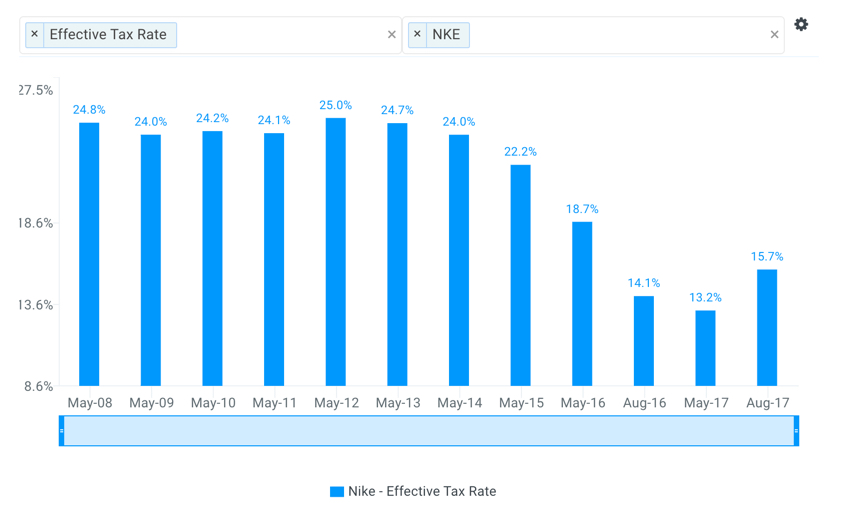
I selected an effective tax rate of 15.0% which is in line with what Nike is currently paying.

Plan Capital Expenditures
Spending on plant, property, and equipment (PP&E), which is often referred to as capital expenditures allows a firm to continue to operate as well as grow its operations. The amount that Nike has spent (as a percentage of revenue) has ranged from 2.3% to 3.5% over the last five fiscal years.
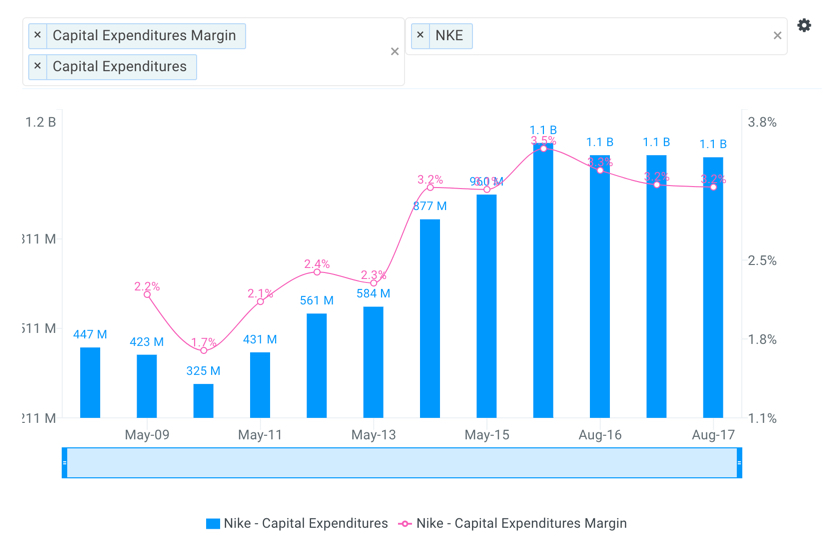
To be conservative, I capped Nike's capital expenditures at 3.6% of sales starting in fiscal year 2019. This is well above its five-year average of 3.1%.
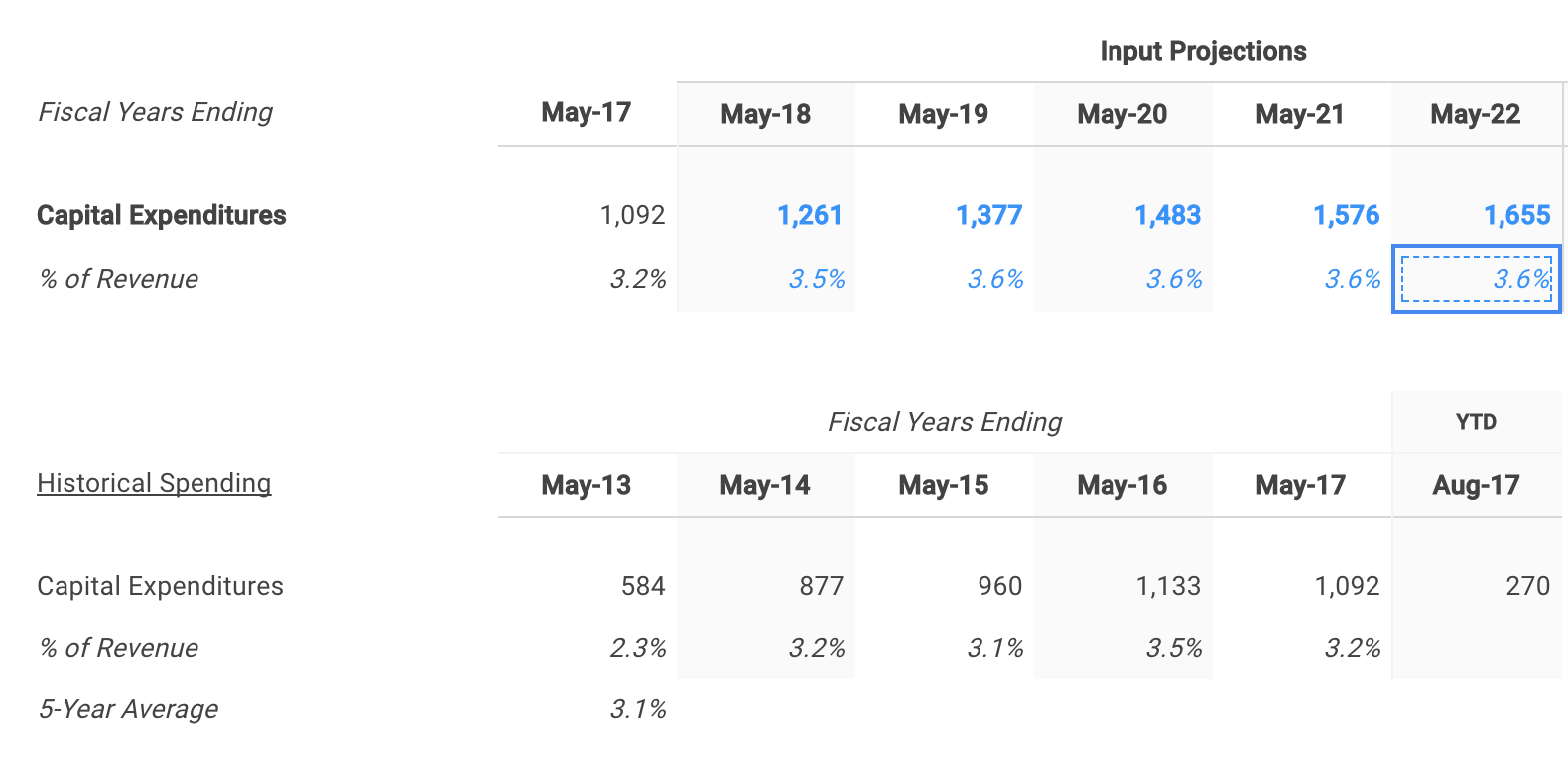
Forecast Net Working Capital Investment
As a company grows, it typically needs to tie up more cash in working capital to manage its day-to-day operations effectively. The model accounts for the impact of this investment by first estimating Nike's net working capital (NWC) as a percentage of revenue and then deducting year-over-year increases from free cash flow.
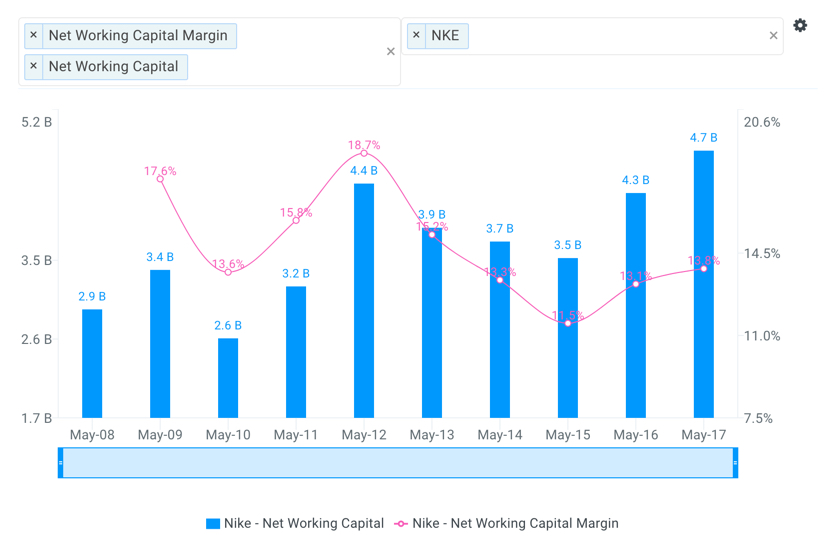
It is important to note that net working capital typically fluctuates more year over year than other DCF assumptions and is generally more difficult to project with as much confidence. Nike has historically required 13.4% of revenue on average for net working capital, but this figure has been as high as 18.7% and as low as 11.5%. The company’s latest fiscal-year NWC margin of 13.8% is in the ballpark, so I kept it at that level in the forecast shown in the figure below.
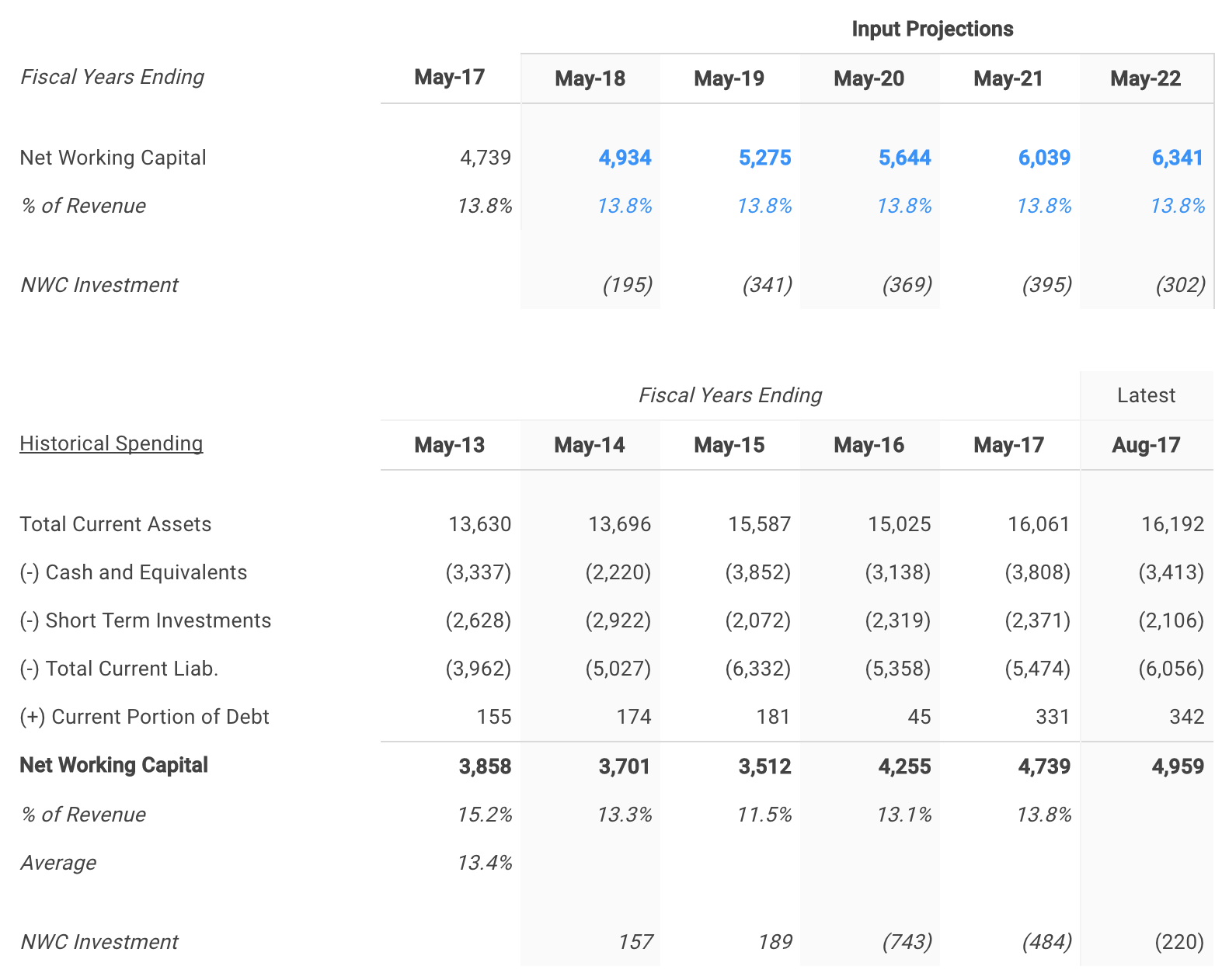
Calculate Free Cash Flow
With all required forecasts in place, the next step is to calculate projected free cash flow as shown below.
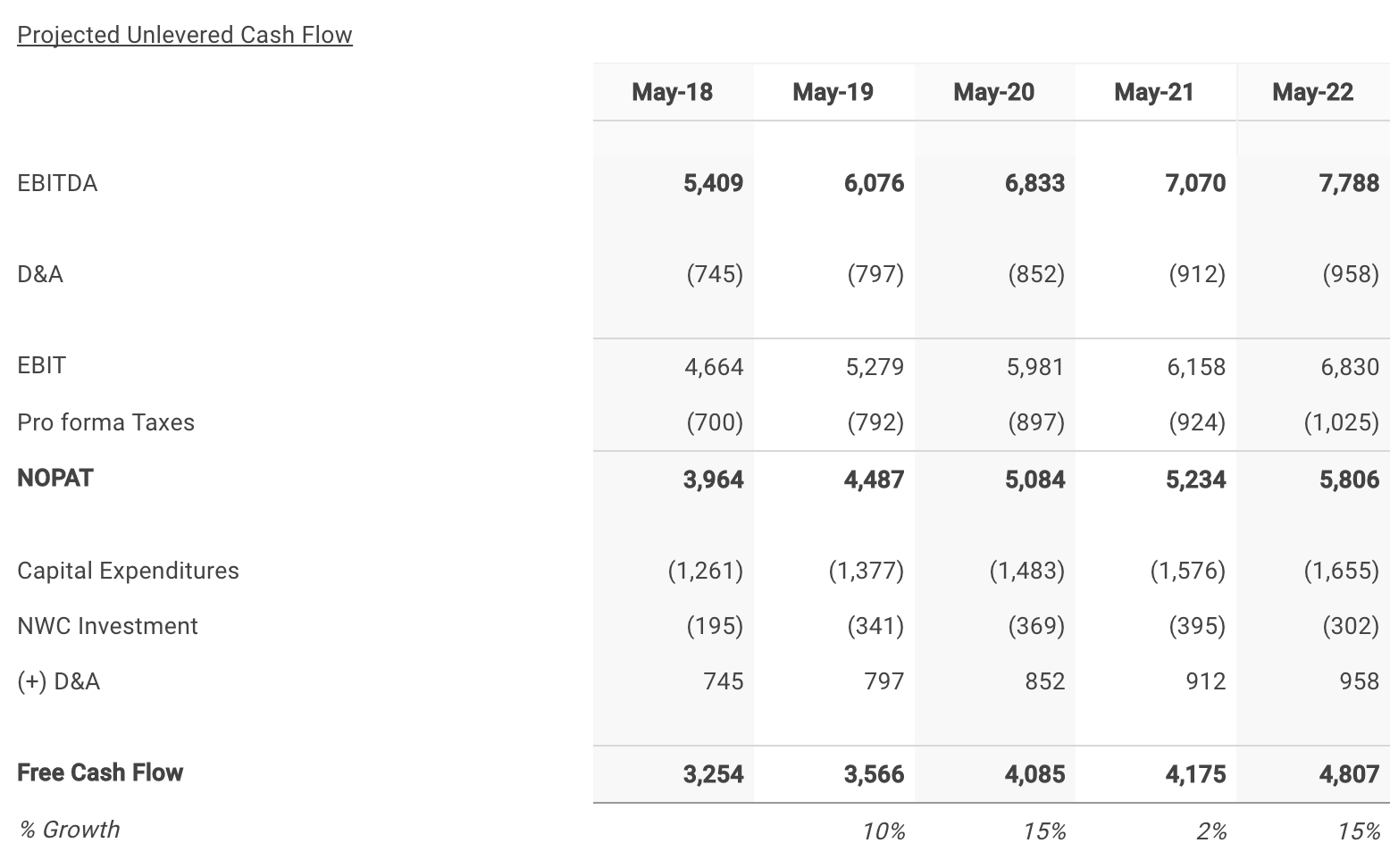
Step 2: Select Nike's Discount Rate
The next step is to select a discount rate to calculate the present value of the forecasted free cash flows. I used finbox.io’s Weighted Average Cost of Capital (WACC) model to help arrive at an estimate. Generally, a company’s assets are financed by either debt (debt is after tax in the formula) or equity. WACC is the average return expected by these capital providers, each weighted by respective usage. The WACC is the required return on the firm’s assets.
It’s important to note that the WACC is the appropriate discount rate to use because this analysis calculates the free cash flow available to Nike’s bondholders and common shareholders. On the other hand, the cost of equity would be the appropriate discount rate if we were calculating cash flows available only to Nike’s common shareholders (i.e., dividend discount model, equity DCF). This is commonly referred to as the difference between free cash flow to equity (FCFE) and free cash flow to the firm (FCFF). By using the WACC to discount FCFF, we are calculating total firm value. If we discounted FCFE at the required return on equity, we would end up with equity value of the firm. Equity value of the firm is simply total firm value minus the market value of debt.
I determined a reasonable WACC estimate for Nike to be 8.0% at the midpoint. An updated cost of capital analysis using real-time data can be found at finbox.io's Nike WACC Model Page. The DCF model then does the heavy lifting of calculating the discount factors by applying the mid-year convention technique.
Step 3: Estimate Nike's Terminal Value
Since it is not reasonable to expect that Nike will cease its operations at the end of the five-year forecast period, we must estimate the company’s continuing value, or terminal value. Terminal value is an important part of the DCF model because it accounts for the largest percentage of the calculated present value of the firm. If you were to exclude the terminal value, you would be excluding all the future cash flow past the horizon period. Using finbox.io, users can choose a five-year or 10-year horizon period to forecast future free cash flow.
The most generally accepted techniques to calculate a terminal value are by applying the Gordon growth approach, using an EBITDA exit multiple and using a revenue exit multiple. This analysis applies the Gordon growth formula:

As the formula suggests, we need to estimate a “perpetuity” growth rate at which we expect Nike’s free cash flows to grow forever. Most analysts suggest that a reasonable rate is typically between the historical inflation rate of 2% to 3% and the historical GDP growth rate of 4% to 5%.
Nike's sales and free cash flows are still growing above 5.0% by the end of the projection period, so I’ve selected a perpetuity growth rate of 4.0% (at the midpoint).
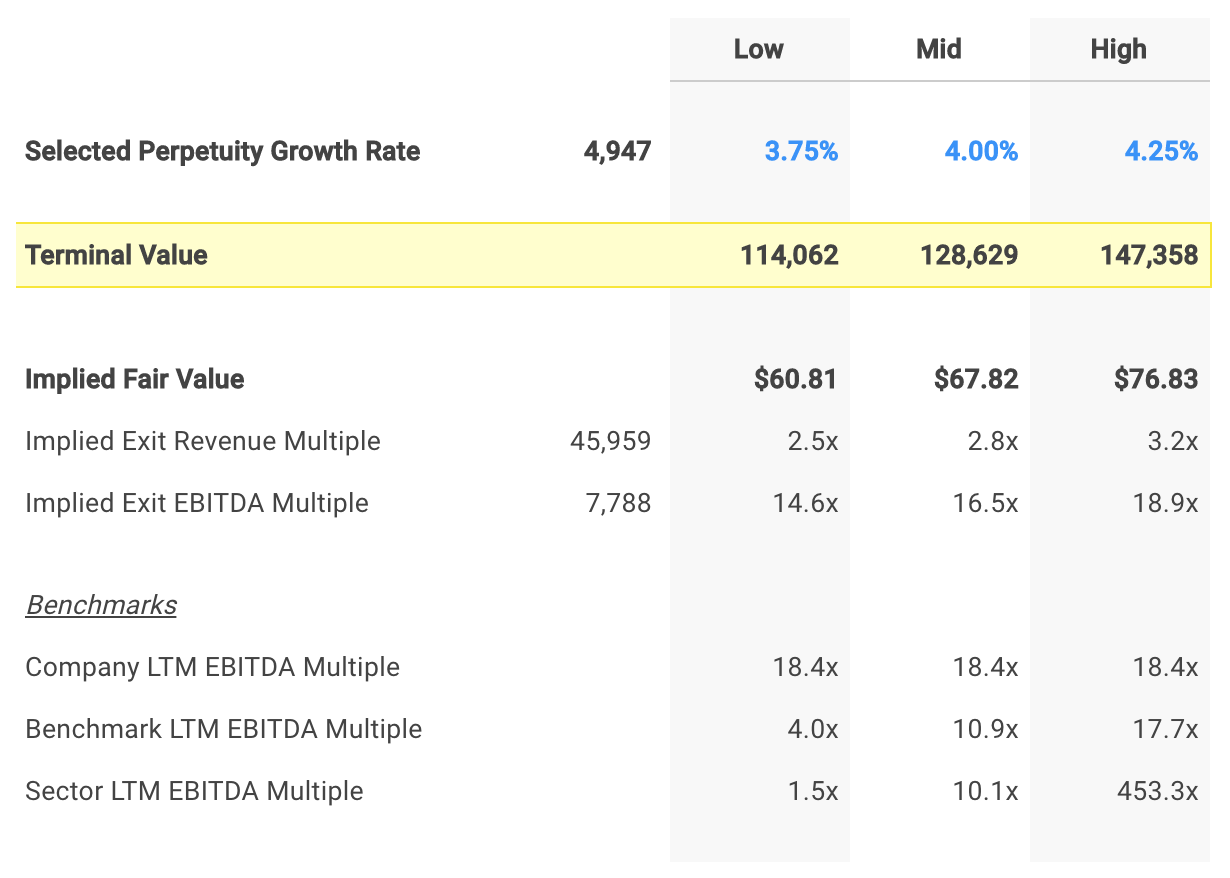
An EBITDA multiple is calculated by dividing enterprise value by EBITDA. Similarly, the terminal EBITDA multiple implied from a DCF analysis is calculated by dividing the terminal value by the terminal year’s projected EBITDA. Comparing the terminal EBITDA multiple implied from the selected growth rate to benchmark multiples can serve as a useful check.
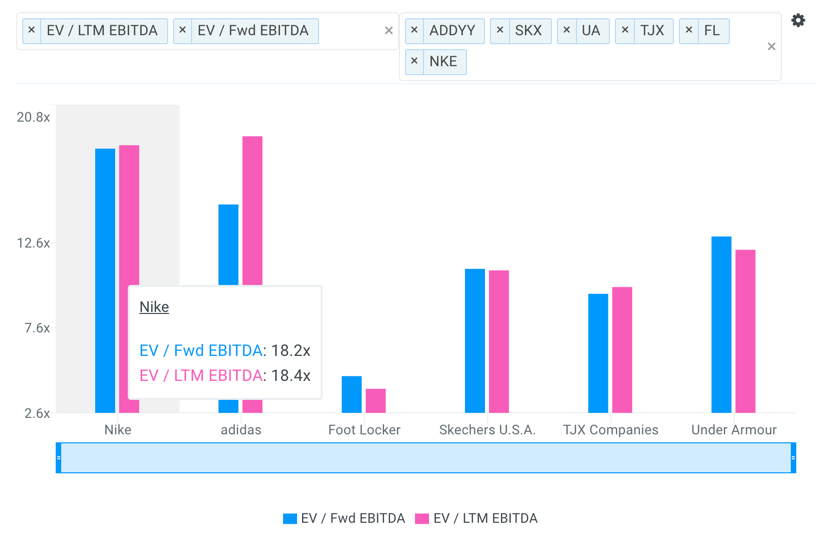
Nike's implied EBITDA multiple of 16.5x at the midpoint is below Nike’s current EBITDA multiple of 18.4x, but still above the benchmark and sector multiples. This seems reasonable because Nike’s 4% growth outlook at the end of the five-year projection period is considerably lower than its growth outlook today, which would warrant a lower multiple.
Step 4: Calculate Nike's Equity Value
The enterprise value previously calculated is a measure of the company’s total value. An equity waterfall is a term often used by valuation firms, referring to the trickle-down process of computing a company’s equity value from its enterprise value. Note that in the event of a bankruptcy, debt holders will be paid in full before anything is distributed to common shareholders. Therefore, we must subtract debt and other financial obligations to determine a firm’s equity value. The general formula for calculating equity value is illustrated in the figure below.

The model uses the formula shown above to calculate equity value and divides the result by the shares outstanding to compute intrinsic value per share as shown at the bottom of the figure below.
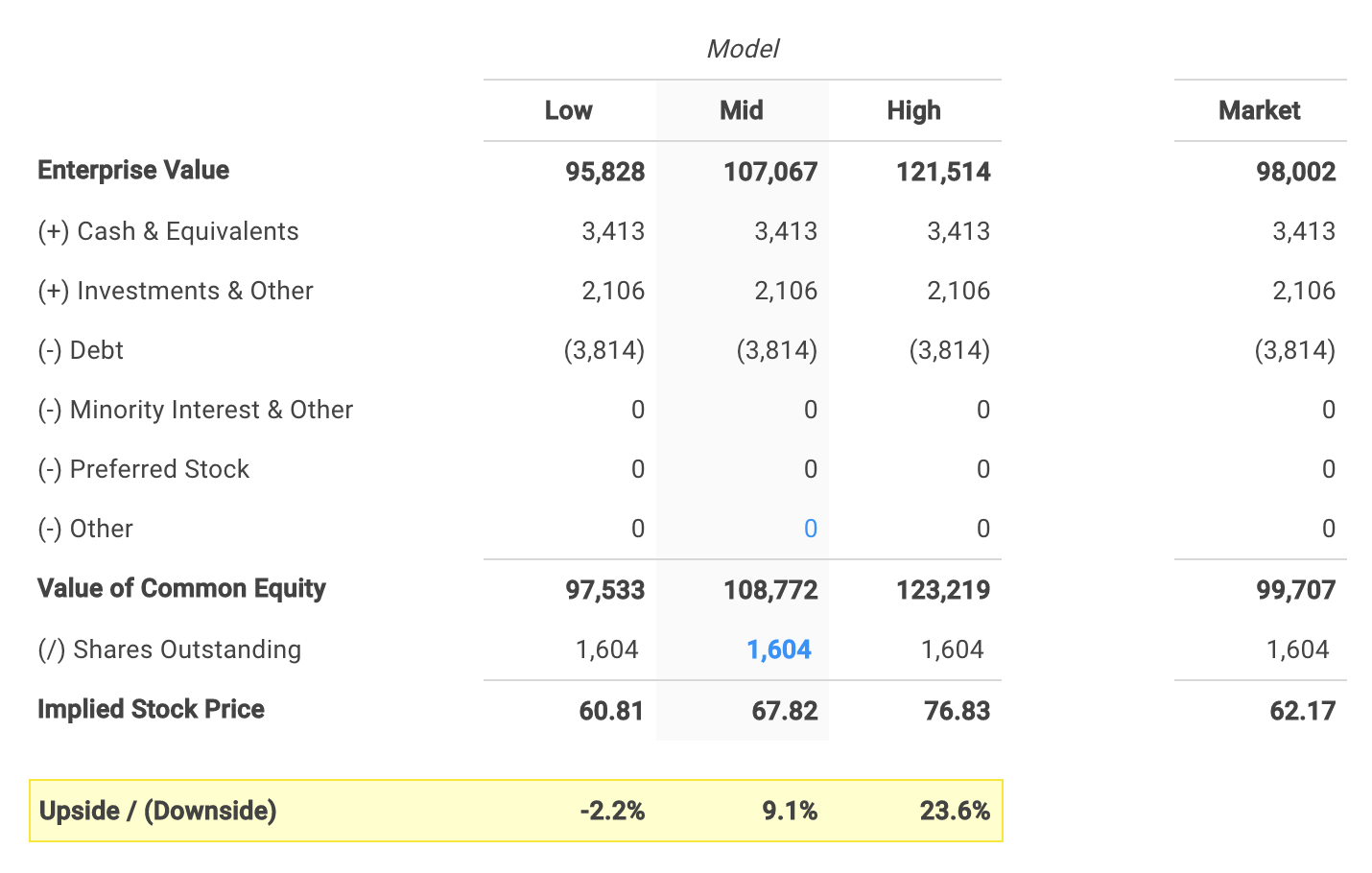
The assumptions I used in the model imply an intrinsic value per share range of $60.81 to $76.83 for Nike.
Nike's stock price currently trades at $62.17 as of Tuesday, December 12th, 9.1% below the midpoint value of $67.82.
Conclusion: Nike Has Nearly 10% Upside Potential
A DCF analysis can seem complex at first, but it’s worth adding to your investment analysis toolbox since it provides the clearest view of company value. Wall Street is expecting that Nike will report Q2 sales and EBITDA of $8,388 million and $1,009 million, respectively. Shares of the retailer could easily jump as much as 10% if management reports a positive earnings surprise on December 21st.
I’ll end with this quote by renowned economist John Maynard Keynes:
“It is better to be roughly right than precisely wrong.”
Instead of focusing on the getting each of the assumptions exactly right, take Keynes’ advice on being roughly right. Select different assumptions deemed reasonable to get a sense for key drivers of value. Apply multiple scenarios (e.g., base case, downside case etc.) to get comfortable with the upside and downside potential of the company.
Although Nike's stock has increased nearly 25% year-to-date, my cash flow analysis implies that shares still have more upside than downside at current levels. For additional detail on my calculations, here's a link to my Nike DCF base case analysis.
This is not a buy or sell recommendation on any security mentioned.
image source: behance
Author: Matt Hogan
Expertise: Valuation, financial statement analysis
Matt Hogan is a co-founder of finbox.io. His expertise is in investment decision making. Prior to finbox.io, Matt worked for an investment banking group providing fairness opinions in connection to stock acquisitions. He spent much of his time building valuation models to help clients determine an asset’s fair value. He believes that these same valuation models should be used by all investors before buying or selling a stock.
His work is frequently published at InvestorPlace, Benzinga, ValueWalk, AAII, Barron's, Seeking Alpha and investing.com.
Matt can be reached at [email protected].

